Frustrated with Centrelink call wait times? MP investigates why they're skyrocketing!
- Replies 57
In the current economic climate, many Australians have become particularly financially vulnerable. The market is tough enough now, let alone if you’re retired or out of work and relying on Centrelink for vital support.
The government has already implemented specific measures to aid those who are struggling, such as the Jobseeker supplement, but unfortunately, many people still face challenges.
The call wait time is much higher now than it was prior to the global pandemic – and listening to an endless loop of repetitive music for a few extra minutes might be the difference between life and death in some situations.
But Casey MP Aaron Violi is determined to rectify this.
The local MP is taking action, launching an investigation and demanding answers from the federal government.
Recently, the cost-of-living crisis has spiked the need for welfare payments, making Centrelink an essential service needed now more than ever. However, this increasing demand has led to significant delays across the board.
During a senate hearing on 31 May, it was revealed that Centrelink call wait times had ballooned from an average of 14 minutes in 2021 to 2022 to a staggering 20 minutes in 2023.
Services Australia CEO Rebecca Skinner explained that until 31 March 2023, only 60.4 per cent of Centrelink customers were served within 15 minutes.
It has been revealed that the issue stems from a staff shortage available to answer all those ringing phones.
She highlighted that ‘the current staffing is about 400 under the average staffing level for this year’.
‘The cap is 28,560 ASL for the 2022-23 financial year, and we were at about 28,151 at the end of 30 March. We are just a bit higher than that now as we’ve entered the final part of the financial year,’ she continued.
In a report made earlier this year, Ms Skinner acknowledged that the increased demand for Centrelink services was also partly due to the changing economic circumstances.
Centrelink's Older Australians line, which can be reached at 132 300, has an average wait time of 24 minutes and 18 seconds as of December 31, 2022. You can read more on this here.
Mr Violi isn't taking this situation lightly. According to reports, he submitted questions to the Minister for Government Services, Bill Shorten, requesting official data on wait times and how long it's taking for locals to get the help they need when they make a claim or visit a Centrelink office.
The questions will formally appear on the notice paper of the senate estimate hearing that’s happening on Tuesday, 13 June.
Mr Violi mentioned his experience with constituents: ‘I have met with constituents and regularly have calls to my office regarding Centrelink payment delays. Whether it be delays processing Youth Allowance, JobSeeker, delays in updating databases with new information or long periods on hold.’
It's crucial that Centrelink addresses this issue, especially amidst the cost-of-living crisis. Mr Violi applauded the hard work of the staff at Services Australia but emphasised the need for further data to identify how widespread these delays are and determine if additional resources are needed.
‘We simply cannot have people waiting weeks for a payment in the middle of a cost-of-living crisis,’ he stated.
Waiting for Centrelink payments can cause extreme hardship for many.
Tania Bevan, CEO of the Dandenong Ranges Emergency Relief Service (DRERS), a not-for-profit organisation assisting those facing crises, points out that ‘70 per cent [of people] are on Centrelink, 26 per cent have no income, and four per cent are on other income such as Workcover. Some of the 26 per cent are waiting for Centrelink payments to begin, so the numbers are high’.
‘I would like to see everyone eligible for Centrelink payments transition to receiving these payments as quickly as possible.’
Shadow Minister for Government Services, Paul Fletcher, believes Australians deserve seamless, simple and safe service delivery from the government.
He stated: 'The federal government must ensure people are spending less time on the phone or in a queue at Centrelink and more time in a job.’
‘Unfortunately, Labor’s track record isn’t great – in February this year, it was revealed that over 2.1 million Australians chose to terminate a call rather than wait on the phone to Centrelink. But there also needs to be a strong focus on enhancing digital platforms like MyGov, so more Australians can access vital information at their fingertips,’ he added.
 Have you dealt with the long call wait times when contacting Centrelink? Please share your experiences in the comments below.
Have you dealt with the long call wait times when contacting Centrelink? Please share your experiences in the comments below.
The government has already implemented specific measures to aid those who are struggling, such as the Jobseeker supplement, but unfortunately, many people still face challenges.
The call wait time is much higher now than it was prior to the global pandemic – and listening to an endless loop of repetitive music for a few extra minutes might be the difference between life and death in some situations.
But Casey MP Aaron Violi is determined to rectify this.
The local MP is taking action, launching an investigation and demanding answers from the federal government.
Recently, the cost-of-living crisis has spiked the need for welfare payments, making Centrelink an essential service needed now more than ever. However, this increasing demand has led to significant delays across the board.
During a senate hearing on 31 May, it was revealed that Centrelink call wait times had ballooned from an average of 14 minutes in 2021 to 2022 to a staggering 20 minutes in 2023.
Services Australia CEO Rebecca Skinner explained that until 31 March 2023, only 60.4 per cent of Centrelink customers were served within 15 minutes.
It has been revealed that the issue stems from a staff shortage available to answer all those ringing phones.
She highlighted that ‘the current staffing is about 400 under the average staffing level for this year’.
‘The cap is 28,560 ASL for the 2022-23 financial year, and we were at about 28,151 at the end of 30 March. We are just a bit higher than that now as we’ve entered the final part of the financial year,’ she continued.
In a report made earlier this year, Ms Skinner acknowledged that the increased demand for Centrelink services was also partly due to the changing economic circumstances.
Centrelink's Older Australians line, which can be reached at 132 300, has an average wait time of 24 minutes and 18 seconds as of December 31, 2022. You can read more on this here.
Mr Violi isn't taking this situation lightly. According to reports, he submitted questions to the Minister for Government Services, Bill Shorten, requesting official data on wait times and how long it's taking for locals to get the help they need when they make a claim or visit a Centrelink office.
The questions will formally appear on the notice paper of the senate estimate hearing that’s happening on Tuesday, 13 June.
Mr Violi mentioned his experience with constituents: ‘I have met with constituents and regularly have calls to my office regarding Centrelink payment delays. Whether it be delays processing Youth Allowance, JobSeeker, delays in updating databases with new information or long periods on hold.’
It's crucial that Centrelink addresses this issue, especially amidst the cost-of-living crisis. Mr Violi applauded the hard work of the staff at Services Australia but emphasised the need for further data to identify how widespread these delays are and determine if additional resources are needed.
‘We simply cannot have people waiting weeks for a payment in the middle of a cost-of-living crisis,’ he stated.
Waiting for Centrelink payments can cause extreme hardship for many.
Tania Bevan, CEO of the Dandenong Ranges Emergency Relief Service (DRERS), a not-for-profit organisation assisting those facing crises, points out that ‘70 per cent [of people] are on Centrelink, 26 per cent have no income, and four per cent are on other income such as Workcover. Some of the 26 per cent are waiting for Centrelink payments to begin, so the numbers are high’.
‘I would like to see everyone eligible for Centrelink payments transition to receiving these payments as quickly as possible.’
Shadow Minister for Government Services, Paul Fletcher, believes Australians deserve seamless, simple and safe service delivery from the government.
He stated: 'The federal government must ensure people are spending less time on the phone or in a queue at Centrelink and more time in a job.’
‘Unfortunately, Labor’s track record isn’t great – in February this year, it was revealed that over 2.1 million Australians chose to terminate a call rather than wait on the phone to Centrelink. But there also needs to be a strong focus on enhancing digital platforms like MyGov, so more Australians can access vital information at their fingertips,’ he added.
Key Takeaways
- Centrelink call wait times have increased from an average of 14 minutes in 2021 to 2022 to 20 minutes in 2023.
- Casey MP Aaron Violi is calling on the federal government to provide official data on call times and Centrelink office visits to determine the scope of the issue.
- Shadow Minister for Government Services, Paul Fletcher, emphasised the need for enhanced digital platforms like MyGov to improve access to essential information for Australians.









